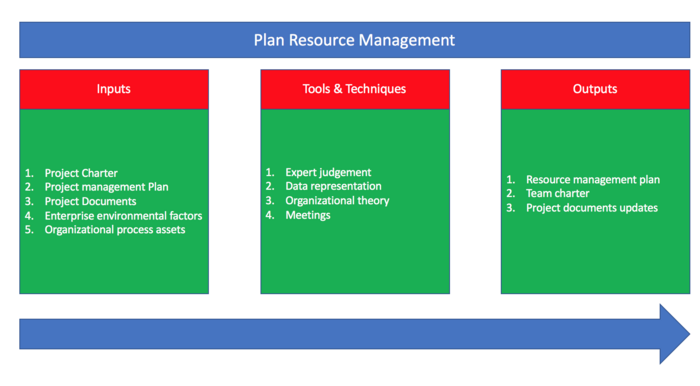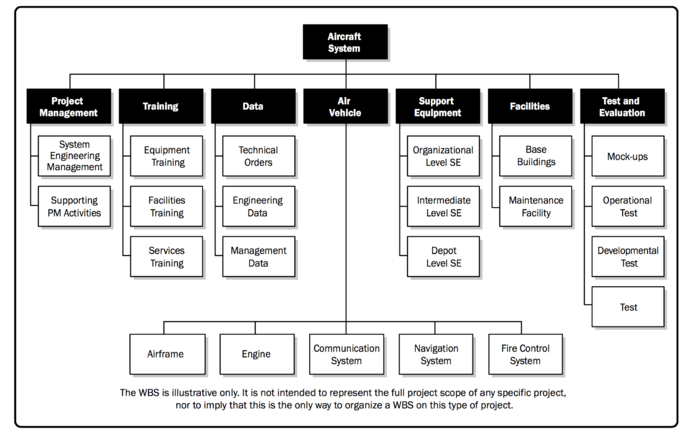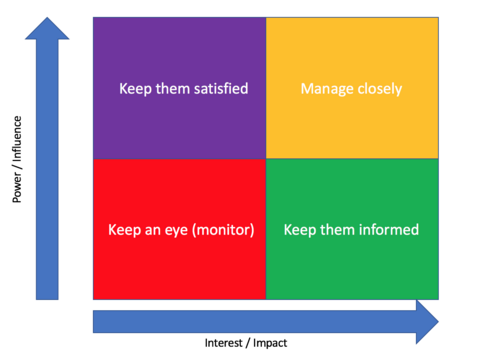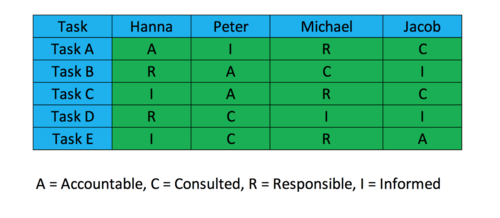Resources in Project Management
Developed by Hedin Gunnarsstein Poulsen - s153658
Contents |
Abstract
Resources are an important aspect of everyday life. It is what you have available to complete a task and get an output. In a project management perspective, it can be anything from time, money, people, facilities and equipment. Proper resource management is important in this matter, as it ensures that individuals are not overloaded with work, and that time is effectively utilized, as well as the final budget must be within or under budget. Often in resource planning, the challenge is to find a baseline and complete the projects on time and to budget. Statistics, however, shows that one in every three projects have no baseline[1] and less than one-third of projects are completed on time and on budget[2]. These are just a few examples of how difficult resource management planning can be. Resource management planning could for instance help project- managers and teams to answer questions like the following:
- Do we have enough space on our budget for new equipment and experts handling these products? What if not?
- Is there anyone who is overloaded with work and is there anyone who has not sufficient amount of work?
- Is there any worker available to work in the Christmas holidays?
- How will adding another project affect the existing projects?
- Is the project on time?
To make sure the right resources are available for the project managers and project team at the right time, there has been developed some project resource management processes/tools[3], to identify, acquire and manage the resources for a successful completed project. The processes are the following:
- Plan Resource Management
- Estimating Activity Resources
- Acquire Resources
- Develop Team
- Manage Team
- Control Resources
In this article, the focus will be on the process of Plan Resource Management
Plan Resource Management
Plan Resource Management[3] is a process to estimate, acquire, manage, and use team and physical resources. The key benefit of this process is that it establishes the approach and level of management effort needed for managing project resources based on the type and complexity of the project.

Plan Resource management is used to ensure that the resources are sufficient and available during the project time and thereby making sure that there is successful completion of the project. Those resources can be found internally and also outside of the organization through a procurement process. In this article, there will be looked at how the elements inside the boxes: Inputs, Tool & Techniques and Outputs are defined.
Project Charter
Defining a project charter[3] is probably one of the most confusing times in the project step because it begins prior to a project is launched, and in that way is very open-minded, to begin with. It is also argued that is the most important part of the project, as it outlines the whole project and more or less will choose the outcome of the project. It is an agreement between the different parts of the negotiation. In the project charter, the project name is identified. There is outlined that It's a formal authorization document for the description of the project. So the description of the project states the need, that this project is going to provide a solution for the organization. It states the organization, the need that the organization has, and the solution that this project is deemed to fit. The project charter also includes key stakeholder list, summary milestones, costs, pre-approved financial resources and also the risk assessment which is attached to the project which is vital for the survival of the project. A Project charter should include, according to PMO at least these topics:
- Requirements
- Business Needs
- Summary Schedule
- Assumptions and constraints
- Business case, including return on investment
Project Management Plan
The Project management plan consists of two elements: Quality management plan and scope baseline. These will now be described further.
Quality Management Plan
Project management quality plan is implemented to ensure that acceptance of quality is agreed upon prior to project start[4], and to set a set of standards defined by the customers and stakeholders, and it describes how the project will make sure to live up to these standards agreed upon. Quality management makes the possibility of meeting the required standards more realistic and makes sure that:
- Product is built upon prior agreements about the standards and expectation.
- Work efficiency is going as planned and there is no delay
- If there is a conflict there will be taken action and the problem will be solved immediately
Normally in the project management quality plan, the project manager, project team, customer and stakeholders are involved. According to PMO, the quality management plan can be divided into three processes.
These topics are already discussed in several wiki-articles. Press the link beside the bullet points for more information on these topics.
Scop Baseline
A scope baseline used to measure, manage, assessing and controlling the project scope[3]. Scope baseline is an actual component of the project management plan. Scope baseline can be changed only through formal control procedures. It contains three elements of approved project documents:
- WBS[5] (Work Breakdown Structure):
- WBS Dictionary
- Detailed Project scope statement

The detailed project scope statement includes the description of the project scope, deliverables, assumptions, and constraints.
To make a picture of what the tool WBS is intuitively, one could take as an example: that you can’t eat an elephant at once alone. One has to divide it up in pieces and eat one piece at the time to complete the task. Another example could be when cleaning a room you have to make it in parts, maybe first clean up the floor and then wash it and afterward vacuum the floor. So the concept behind WBS is very simple and is that every complex project task can be broken down to smaller task until you meet a point where it is not possible anymore. WBS works the same way for companies. The work breakdown structure helps to visually see all the components that make up the task and ultimately make up the entire project. A typical WBS has around 3-6 levels.
The WBS dictionary is a more detailed part of the WBS about every element it may describe. It describes milestones, costs, deliverables, acceptance criteria, schedule etc. While WBS could be used for a higher level manager, a WBS dictionary is more for the people involved in a certain sub-division area of the WBS like middle/project managers to see a more detailed project plan.
Project Documents
The project document is an overview of the whole project. That is the time schedule, the risk associated with different parts of the projects, who are the stakeholders and what influence do they have on the project and who is responsible for what, so that the project can succeed.
Project Schedule
The project schedule shows how the activities are linked with planned dates, durations, milestones and resources. All project schedules have a start date and an end date. To control these companies and project teams are most often using Gantt Charts to represent schedule. To read more about Gantt charts press here: Gantt Chart
Risk Register
Risk is a very important element in project management as it mostly ensures that the projects starts up on the right foot and that it is vital to the degree of quality. Also it makes sure that all the barriers which could interrupt the project phase are identified. To get an overview of what the risks are with the different parts of the project a risk-analysis is performed.[6]. The risk in this tool is based on two parameters, they are consequences and probability.

From the figure above there can be seen that a risk-analysis is a function of consequences. The risk-analysis is made in the following way:
- Brainstorming: What can go wrong?
- Asses the consequences high to low.
- Asses the probability that a certain part may happen.
- Calculate the final risk (probability x consequence).
- Come up with solutions that can reduce probability and consequences
Stakeholder Analysis
To identify the important stakeholders and their influence and interest in the project a stakeholder analysis can be used.[7]. Stakeholder analysis is a strong tool and is applied for getting more information about the stakeholder environment and to prioritize management resources. Stakeholders are the resources. Product, services we are delivering or people delivering to us, these are all stakeholders and by making a stakeholder analysis it is possible to align the stakeholders and make assessments.
The first step is for the management to identify the stakeholders. After all the stakeholders are listed they need to be listed in terms of power and interest. This for getting information about the influence the stakeholder has on the project. The influence/interest table can be listed in 4 boxed and are described in the following:
- Manage closely : These stakeholders have high interest and influence. These are the most important stakeholders. It is extremely important to keep them satisfied. Keep them updated all the time, make them involved in decisions and always find out what is important to them and help them out.
- Keep them satisfied: These stakeholders have high power but very little interest. As these stakeholders are very powerful the main goal is to increase their interest by inviting them for meeting and asking them all the time. They can cancel resources at any time, so they need to be under the monitor all the time and try to move them to the box “Manage Closely”.
- Keep an eye: These stakeholders are not that powerful and have little or no interest in the company. The goal is, therefore, to keep an eye on them and try to increase their interest in the project as they could move to another position in the future.
- Keep them informed: These stakeholders are mostly external. These people have very low power and very high interest in the project. This group should always be informed as these stakeholders often can be very helpful with consultancy for the project.

Responsibility Chart
To transform input to an output, there must some tools/equipment for helping to make sure the different tasks are being implemented and on schedule. To do this, a selected person to a specific task must carry the responsibility to carry out the project. The Responsibility chart[3] is a useful tool to divide the responsibility up. In the responsibility chart, there is mentioned who has the responsibility task. To each task, there are 4 persons involved and these have the following responsibility roles:
- Responsible: The one who is completing and delivering the task. This person may get assisted during the process.
- Accountable: This person is the authority aspect of the project. The main goal is to approve the work the responsible has done. Only one accountable can be set for each action
- Consulted: These are the consultants. These are often specialized people and experts who know a lot about one thing and are consulted before taking a decision. Input from these people is necessary. This is mostly a two-way communication system.
- Informed: These are people who need to be informed when a decision is taken. This is mostly a one-way communication

Enterprise Environmental Factors (EEF) and Organizational Process Assets (OPA)
Enterprise Environmental Factors
The environment is basically always fluctuating.[3] The environment can be defined as anything which belongs to the natural world and is more or less uncontrollable. EEF is a condition that controls the project but as a project manager, you don't have control over the EEF. The environment does affect a project both positively and negatively. In an environment, one can distinguish between external and internal environment.
External:
- Government regulation
- Market conditions
- External political Condition
Internal:
- Organizational culture
- Types of organizational structure
- Internal political conditions
- Available resources
- Infrastructure
Above are some examples of the internal and external points. For instance, in the external point, the government can increase the taxes and it would make the project team forced to revise their project plan, budget etc. Market conditions could also happen if a new threatening competitor enters the market.
Some example of internal environment could be the organizational culture. The company has a vision and a mission strategy as well as values, beliefs, norms, leadership style, ethics, religion etc. Resource availability is also another good example of the internal environment. All in all, there are a lot of environmental parameters to consider and to cope with this the whole unit, company, consultant etc have to take into account how to cope with these problems and opportunities.
Organizational Process Assets
Assets can be defined as something you own or control and helps you achieve goals. For instance, you use your vehicle to get to work. The same way organizations also use assets to move from A to b to achieve their goals. These are called Organizational process assets[3].
The OPA's can be sorted into two groups according to PMO. The first one is
- Policies
- Procedures
- Standard template
- General guidelines
These points are quite general and do not belong to project work. These could, for instance, be that you must use intranet policy at work, or you must fill out a certain template and also general guidelines like time reporting, Human resource rules etc.
The second one is based on knowledge basis, also known as historical data:
- Risk Register
- Lessons from previous times
- Techniques
- Historical information
It is thereby understandable that with knowledge basis from the previous year will save a lot of time. Many things are not made from scratch. The methods, contacts, procedures etc are already there. It is therefore important to look at what the unit learned from the past and what mistakes they did, so they don't use unnecessary valuable time at the start of the project.
Team Charter
With the previously mentioned information, a team charter[3] can be established. A team charter is simply a document where the project team has written information about how they are going to carry out the project. It is a summation of all the inputs and tools, in the resource management plan, that is used and shortly summarises those. The team charter could have the following points:
- Mission & Objectives: What is the purpose, goal, and mission of the team? Why are we doing this?
- Scope: What do the stakeholders expect? What is the timeline of deliverables? what is the cost?
- Team Members: What roles do our team members have? What are their unique skills? What is their decision making authority?
- Resources and support: Are we going to support the team with training and mentoring programmes? Upper management support?
- Communication guidelines: How often will we meet? how are we going to communicate? is the meeting going to be in person or through skype?
It can be seen that those points are a "follow up" on the Plan Resource Management model. It describes how the inputs are handled with some tools and is an overview of what has been discussed. For instance, the project charter could be set into mission & objectives, while stakeholder analysis is more in the scope. .
Conclusion and limitations
During this article, the focus has been on the process in resource project management called Resource Management Plan. For many of the input bullet points, there has been proposed a tool to make it possible to get output and to help identify different parameters such as stakeholders, responsibility issues, risk, WBS, etc, which all are important for the outcome of the project. There has also been discussed about the importance to keep an eye on what happens in the environment and how project work gets easier when it is "Learn from the past", that is having old procedures which you can use again, there is no need to re-invent the wheel. If this is the case the project management team does not have to start from scratch. During this article, there could have been proposed even more
Summary of the tools which were used tools which were used are:
- WBS: a tool which divides the project down in smaller elements
- WBS dictionary: The same as WBS just more detailed
- Risk-analysis: A tool used for setting different
- Responsibility Chart: Who is responsible for what, who approves, who do we consult and who do we inform about the project progresses?
- Stakeholder mapping: Identifying very important stakeholders and less important.
Limitations
There will always be limitations regarding a theory. Theory and practice sometimes do not result as expected.
The tools presented in this article are not always the most optimal. They are just one of many tools developed and used for the different input points. Also, we cannot assume a stable working environment, things change.
Scope: Not sticking to the original scope can change everything. Because of many change requests, this may add up on delayed projects or over-budget projects.
Stakeholder analysis: To identify stakeholder the stakeholder analysis tool should be sufficient enough. But the model could maybe be expanded to boxes within the boxes where there could be addressed what is important to the stakeholder and what strategy is going to be taken into account to keep this stakeholder, or for increasing the power and influence for the stakeholder. This for getting more information on the stakeholder and with the extra information, a solution could be proposed on how to keep the stakeholder satisfied on a long term.[8]
Conflicts: Humans do not enjoy the company with all people and each individual has its own opinion. This may lead to conflicts between different parts and this could affect the project as well, just like the scope. It is therefore very important to have a clear communication guideline and be a good listener.
Risk: Risk is always an uncertain process as this is all based on probability and mostly on the external environment.
Environmental: The environment can change any model in the article. We are not lords of the environment and therefore a project can go fatal without even the project managers doing a bad job. It is therefore very important to keep an eye on environmental factors, for example, the political situation in the belonging country.
Annotated bibliography
- ↑[Project Management Institute, A Guide to the Project Management Body of Knowledge (PMBOK® Guide) (6'th edition] is used throughout the article. The book contains several topics on project management. In this section, the focus has been on chapter 9.1. The book describes how resources are defined in a project management perspective. All the Plan Resource management model is based on this book and some extra information is inspired from other books. The book shows systematically how Plan Resource Management model is working.
- ↑ Stakeholders: Theory and Practice, A. Friedman and S. Miles, 2006, Oxford University Press, Oxford: This book contributed with a lot of theory about what stakeholders are and different approaches on how they can be found.
- ↑ Practice Standard for Work Breakdown Structures (2006): A PMI guide on how to use a WBS-structure. Used this book to get some information about the work breakdown structure. The book describes how a project manager can define project deliverables and manage this successfully
Annotated figures
- Figure 1: The figure is made by Hedin Gunnarsstein Poulsen with inspiration from PMI book.
- Figure 2 is from the PMI book.
- Figure 3: The figure is made by Hedin Gunnarsstein Poulsen with inspiration from PMI book.
- Figure 4: The figure is made by Hedin Gunnarsstein Poulsen with inspiration from PMI book.
- Figure 5: The figure is made by Hedin Gunnarsstein Poulsen with inspiration from "Stakeholder theory and practice" book.
References
- ↑ [The State of Project Management, Annual Survey 2016, APM PMO specific group, page 7']
- ↑ [CHAOS MANIFESTO 2013, Think big, Act small, page 1']
- ↑ 3.00 3.01 3.02 3.03 3.04 3.05 3.06 3.07 3.08 3.09 3.10 Project Management Institute. A Guide to the Project Management Body of Knowledge (PMBOK® Guide). Sixth Edition; 2017
- ↑ [Patterson, J. L. (1983). Quality management: the project managers [sic] perspective. Project Management Quarterly, 14(1), 33–38.']
- ↑ [Practice Standard for Work Breakdown Structures (2006),PMI']
- ↑ 6.0 6.1 Lavanya, N. & Malarvizhi, T. (2008). Risk analysis and management: a vital key to effective project management. Paper presented at PMI® Global Congress 2008—Asia Pacific, Sydney, New South Wales, Australia. Newtown Square, PA: Project Management Institute.
- ↑ 7.0 7.1 ''Stakeholders: Theory and Practice, A. Friedman and S. Miles, 2006, Oxford University Press, Oxford
- ↑ [Smith, L. W. (2000). Stakeholder analysis: a pivotal practice of successful projects. Paper presented at Project Management Institute Annual Seminars & Symposium, Houston, TX. Newtown Square, PA: Project Management Institute.']